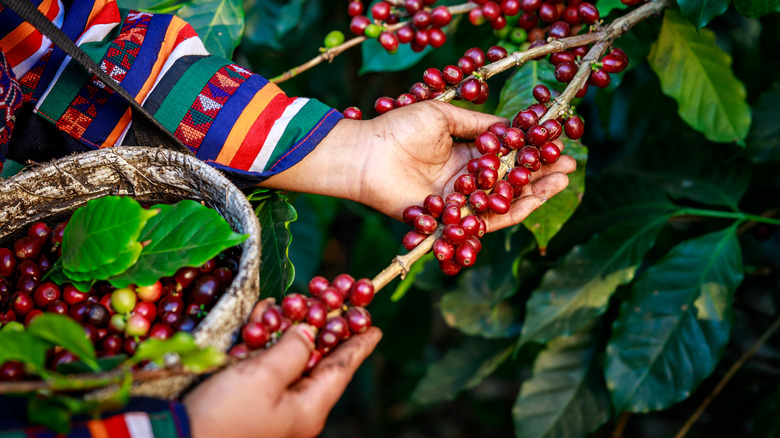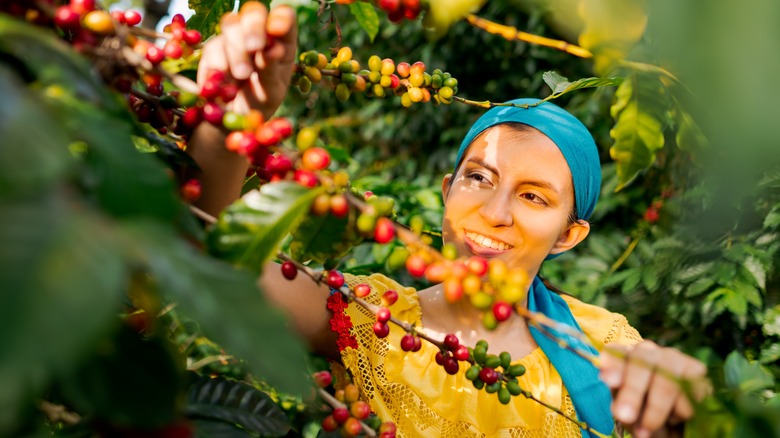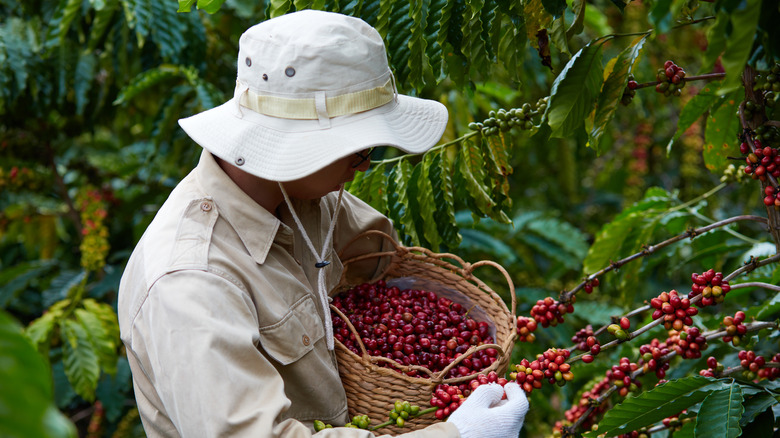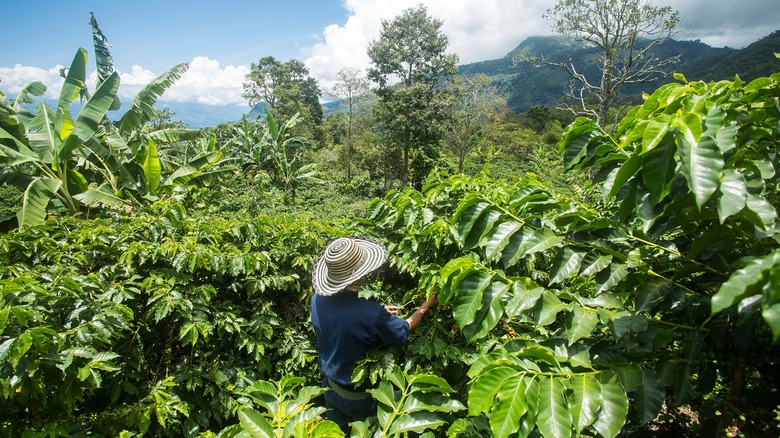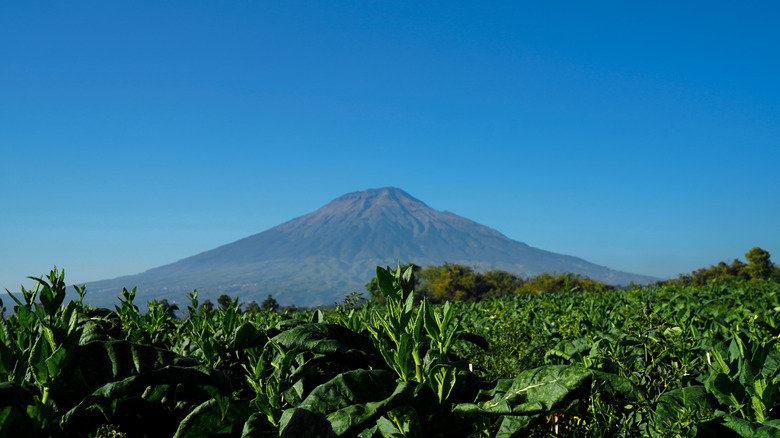What Your Coffee's Source Country Tells You About Its Flavor
If you pay close attention to the packaging of specialty or single-origin coffee, you'll notice it puts a lot of stress on where the coffee is grown. Be it Brazil or Colombia, the name of the country and sometimes even the region is proudly written in bold font, printed front-and-center on the label. You see, it's not just a marketing trick. Just like with wine, by knowing where your coffee came from, you can make pretty good guesses about how it tastes. This phenomenon is known as "terroir," which translates to "sense of place" in French.
Like any plant, coffee trees and their cherries are greatly influenced by the environmental conditions in which they are grown. The loaminess of the soil, the altitude, the temperature, how much rain there is, and so on — all leave their marks on the final beans. Generally, the brew tastes better when the seeds develop in favorable conditions. You'll notice these flavor nuances the most in single-origin coffee, which is guaranteed to come from one geographical area. Of course, taste is a subjective experience, so you'll have to try each kind yourself to really get how their flavors differ. With that said, here's a broad overview of what to expect from single-origins grown in each of these notable countries.
Brazilian coffee is balanced and mild
Brazil currently holds the title as the largest producer of coffee in the world, producing about 54 million 60-kilogram bags (around 7.1 billion pounds) of coffee in 2023, per Statista. The vast majority of the products grown here are arabica, although a few states like Espírito Santo and Rondônia also grow canephora species, also known as robusta. The flavor of the coffee will differ pretty significantly depending on what state you source it from. But no matter where you get your joe from, Brazilian coffee is generally regarded as having very low acidity across the board.
Unlike other South American coffee-producing countries that grow their beans at altitudes well exceeding 5,000 feet, Brazilian plantations tend to be situated at lower elevations — around 3,600 feet. The lower altitude translates to lower acidity in the beans since the higher the coffee plants are grown, the slower they mature (which means they have more time to accumulate flavor). Because of this, Brazilian coffee has a reputation for being very smooth-tasting, often with pronounced nutty notes, complemented by hints of spices and chocolate.
Besides the cheap cost, this balanced flavor combination is the reason why Brazilian coffee is so popular not just among consumers, but large brands like McDonald's and Panera. You can make a brew that anyone can appreciate — be it a coffee enthusiast or someone who just wants something strong to wake up in the morning.
Vietnamese coffee is notoriously bold
Second behind Brazil is Vietnam, which Statista shipped about 26.3 million bags (around 3.5 billion pounds) of coffee in 2023. Unlike Brazil, which produces primarily arabica, Vietnamese coffee is nearly entirely of robusta variety. Given this species' reputation for being much bolder than arabica, you can expect a first sip of Vietnamese coffee to pack a powerful punch, even before considering the influence of terroir.
The coffee is very aromatic, but when tasted, it has a distinct bitter edge, complemented by tasting notes that further accentuate its bold character like chocolate and some nuttiness. Don't expect any floral qualities to show, though. This intensity is precisely why many Vietnamese prefer to enjoy their coffee with condensed, sweetened milk ("cà phê sữa") rather than traditional creamer. It's the only way to temper the brew's robust flavors (although it can also be enjoyed black in a brew known simply as black coffee, or "cà phê đen").
Most Vietnamese coffee plantations are in the Central Highlands region at altitudes of over 600 feet. Even though robusta doesn't need to be grown at very high elevations like arabica, most plantations in Vietnam still sit at these heights to give the beans more complex flavors.
Colombian coffee is intensely acidic, but also fruity
Colombia secures the third spot, having produced approximately 11.5 million bags (about 1.5 billion pounds) of coffee in the 2023/2024 market year, per the U.S. Department of Agriculture. The country has two things going for it when it comes to coffee production: It's near the equator, so it gets warm sunshine throughout the year with few weather variations, and the Andes mountain range that runs through much of the country. Built atop the Andes, plantations could sit as high up as 3,000 to 7,000 feet. The high altitude is very favorable for the growth of the prized arabica variety, and Colombia has seized this opportunity well if the reputation of its coffees is any indication.
But enough about that — how does the altitude affect the taste of Colombian coffee? The most exclusive of its coffees, grown in alpine regions such as Huila or Nariño in the south, are intensely acidic to the point of being citrus-like thanks to the altitude. Beyond the initial tang, you'll detect a fruity sweetness in the brew, followed by a hint of nuttiness in the aftertaste. Beans sourced from lower regions of the country such as the northerly departments of Guajira and Magdalena are grown at elevations between 3,000 and 5,200 feet, so you can expect a less acidic profile. They lean more toward nutty or herbal flavors while also being less bright (i.e. acidic).
Indonesian coffee is earthy and deep
Even though the country produced just about 9.7 million bags in the 2023/2024 market year, coming up fourth on the list, Indonesian coffee is still prized among enthusiasts everywhere. The reason can be found on a small Indonesian island: Java. This is a name that's nearly become synonymous with coffee itself thanks to the excellent terroir of Java.
The island enjoys warm sunshine year-long, a lot of rain thanks to its monsoons, but most importantly, the entire region is blanketed in volcanoes. Volcanic soil is extremely rich in nutrients, a quality that translates well into the full-bodied flavor of the beans grown here. Ask any coffee taster to describe a cup of Java, and you'll curiously receive vastly different responses — that's just how complex its flavor is. But above all, nuttiness and a malt-like taste are popular descriptors.
Besides Java, you may have heard of Sumatra coffee before. This type is characterized by its unique wet-hulling processing method (different from the wet-processing technique) in which the protective outer layer of the bean is removed before drying. The result is a very earthy brew. It's definitely not for everyone — some have likened it to mushrooms, while others think it tastes like shoe leather. But you know what they say, don't knock it till you try it!
